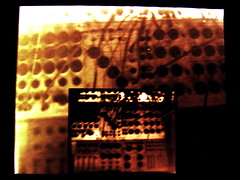Synth programming is simple. It is just a matter of tweaking a few parameters by controlling oscillators’ pitches, ADSR-envelopes and modulating the signal.
Right? Wrong!
Understanding how these parameters work is one, but really understanding how these parameters are interacting with each other is a totally different story. Sometimes changing one parameter can completely change the whole sound. It happens to me now and then that while I am in the middle of creating a nice sounding patch, I forget to save the patch and by turning a couple of parameters to improve the sound, the patch is starting to sound worse. Instead of improving it, I am ruining my own patch!
So yes, rule number one: save often and add a version number at the end of the patchname.
Reason‘s Subtractor synth is a classic synth, based around filtering the oscillators. Although it might look simple, there’s a lot to explore by finding out how the parameters interact with each other. When I first bought Reason version 1.0, in 2000, and started programming Subtractor patches for my own use I was only scraping the surface. At that time I was not interested in VSTi’s, so Reason was my only sound source. So there was this urge for me to master the tool. Being able to focus on one instrument really helped me a lot. Yes, rule number two: numbers do count, start by mastering one tool, before considering buying another one. Buddhists have got it right: simplicity is the way for “moment-by-moment awareness and ‘seeing deeply into the nature of things'”.
The other important factor, rule number three, is patience and time. Time changes everything and by doing something for a long time, you will get better in doing it. When I was programming Substractor and Malström patches for the Reason 3 Factory Soundbank that was a relative easy task because I had explored those synths for a couple of years, day in, day out.
But what works for me, might not work for you. Please let me know how you feel about creating patches. Would extra tutorials from my side be helpful? Some screencasts maybe? Just leave your comments. Although creating patches for synths is part of my profession, I feel that tutorials might even be more helpful for anyone who would like to create their own patches.
Photo by ica~icarus
Note: If you are interested to find out what kind of sound design work I have been doing for powerFX, Propellerheads, FabFilter, ReasonBanks just check the Sound Design page.


4 Comments
[…] Melodiefabriek a producing blog by Marco Raaphorst is mostly based on Reason, but he has some good point now and then, like this one on designing synth patches. […]
Yea, some tutorials with screen shots will be helpful.
Good common sense advice, Marco. I agree that frequent saving of one’s “patchwerk” as it morphs in response to the designer’s tweaking is smart. Why should we treat an evolving sound design/patch any differently than we treat a recording session? Probably wise, also, to use the “save as” (or equivalent) function after each important modification. One could then use a title that briefly describes the pertinent modification when naming each subsequent “save as” file. In my experience, and I am sure yours and many others, such a practice will produce far more than one useable patch. (One could apply the same methodology to sample creation as well.)
Ahem…My real reason for writing is to warn you that a Google Ad floating around on your website could be the undoing of us all. It states in no uncertain terms that patches are life-threatening, and I quote from the ad now:
“In November of 2005, a lawsuit was filed on behalf of a 14 year old girl who had used the patch for only 8 weeks and developed deadly clots in her pelvis.
One of the most recently filed lawsuits was filed on behalf of a 35 year old woman who suffered from severe headaches, nausea and vision problems before dying from blood clots related to Ortho Evra.”
END OF QUOTE
The law firm that placed the ad will sue the company that produced the Ortho patch. I did not take the time to read what company they are suing. I don’t think it is Propellerhead, though. I hope it isn’t Native Instruments. My guess is IK Multimedia. I think I remember coming across the Ortho Evra patch on Sonik Synth. Anyone?
That Google Ad story is so strange. That must be a joke, right? Are they really talking about a sound patch?